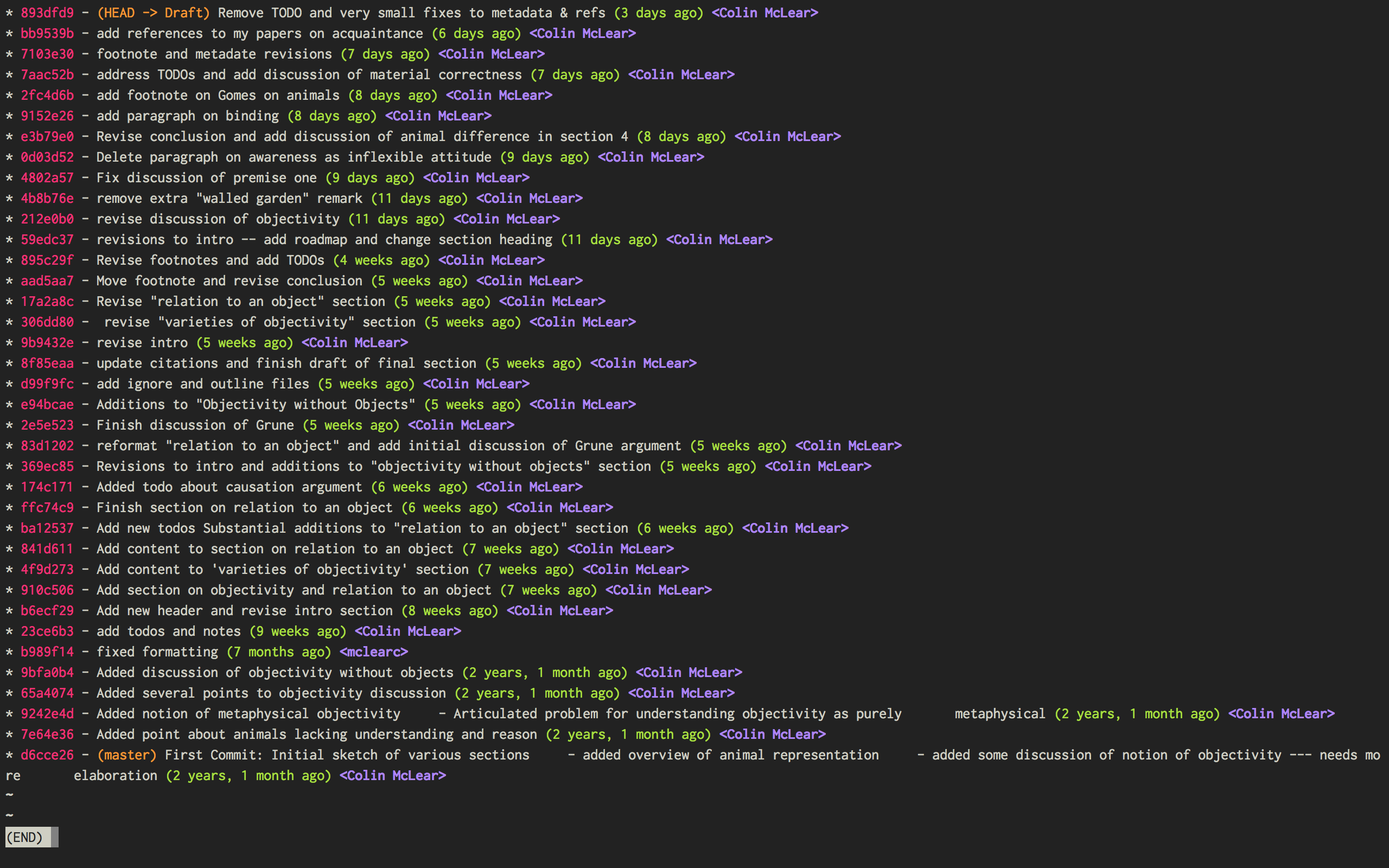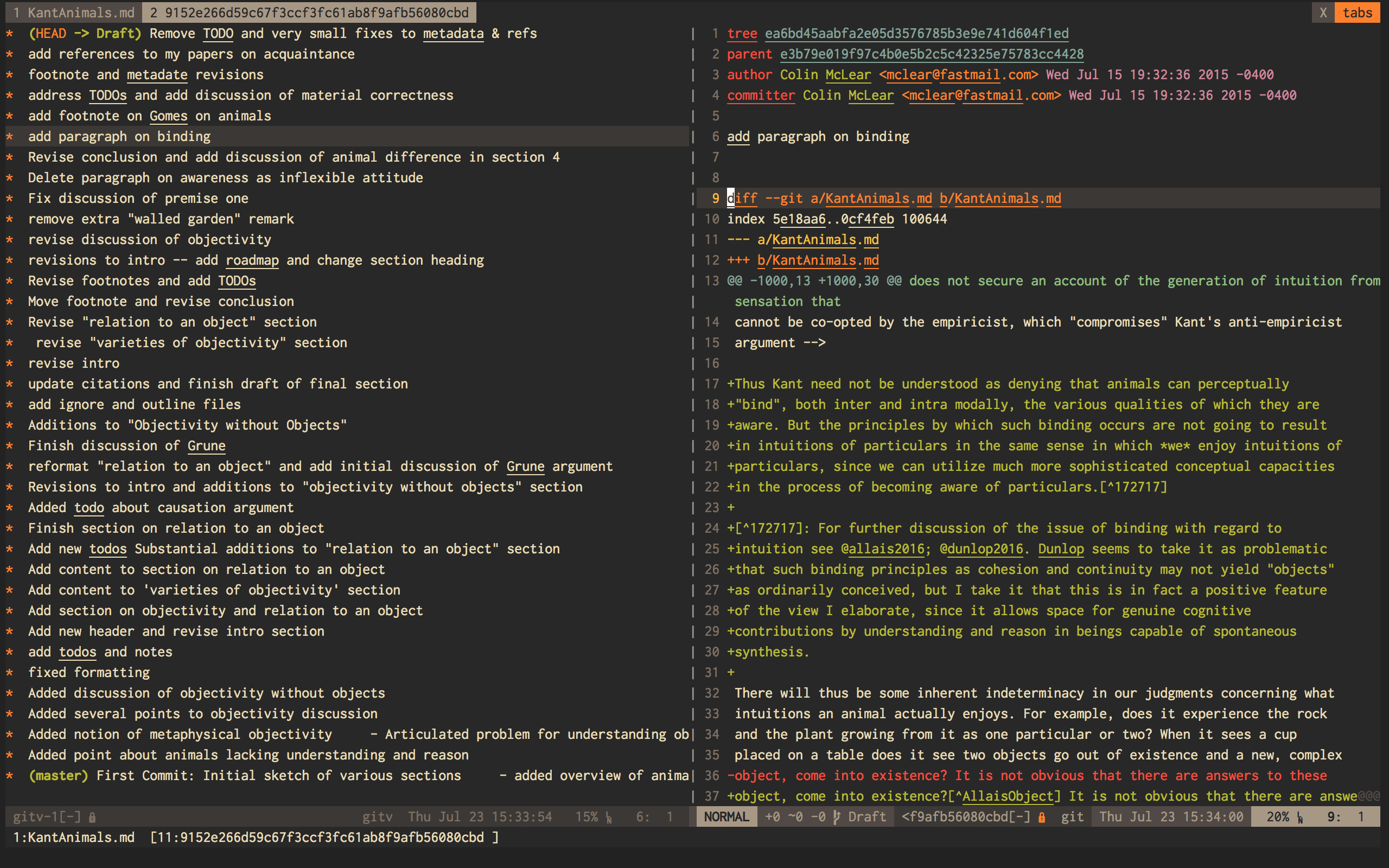Academic writing typically requires writing something in drafts. Many drafts. Until recently there have been few ways of elegantly handling this. Often, one would need to title the current draft with the day’s date, then save this draft in a folder (named, e.g., “drafts” or “versions”), and do this every time one sits down to write. This works, in some ways. The data is there. The problem is that you quickly end up with a folder (or desktop’s) worth of files. These filenames have typically ridiculous and increasingly obscure titles (e.g. final-draft-final-revision\final-draft-04-2018.docx). And it is seldom clear, using this method, exactly what one did when, without actually opening a particular file and looking, or trying to remember when (and where) it was that one made the relevant change.
Nowadays, especially if you use some sort of cloud-based word-processor, it’s likely that you have access to various ways of looking at your version history. For example, Google docs has a revision history option (something similar exists for Dropbox, which lets you easily move back and forth among different versions. Revision histories of this kind offer a way to automatically back up one’s writing. This is especially helpful if you’re not the type of person to carefully name each day’s writing with a new time/date stamp and save them all in the appropriate folder. There are also service (as opposed to application) specific ways of tracking changes to a file. At least some of them allow you to compare differences between versions of files. But at least two things are missing. First, there is no straightforward way of seeing what has changed where, and to see this at arbitrary levels of granularity. Second, in order to see what’s changed when, you have to look in the document itself. There is no general log of the changes you’ve made to the file.
Here’s what I have in mind:

Figure 1: Change Log
You see here a series of entries going back over two years, with a description of what I took to be the most important changes at the time. I can then open any one of the those entries and see a more detailed, line by line, description of changes. This is called a “diff”. I can also roll back the version of the file I’m working on to any of these changes. Each “commit” is a snapshot of the relevant files at the time, which I can retrieve at any point.
I think this is a really nice way to track and visualize one’s progress on some piece of writing. This is hard to do with standard word processors and their means of versioning, but very straightforward to do with a more sophisticated kind of version control system. A version control system can manage changes to a file at an extremely fine level of grain–down to a line or character if necessary. While this system was originally adopted by programmers, it can also be very useful in academic writing (or really any writing where multiple drafts are created).
This form of version control pictured above depends on a system called Git.
The basic idea is that, using whatever writing application one likes, one tracks changes to a document, or a whole directory of documents (e.g. adding image files for presentations, or additional parts of a document kept in separate files when writing longer works like a thesis or novel). The changes can be tracked at an arbitrary level of grain–to the sentence, word, or character–and different versions can be easily compared. All of this can be done without generating lots of files with different numbers or date/time stamps. Everything is kept in a database that one can easily interact with using either the command line or some form of graphical interface.
So far, this isn’t necessarily any different from what one can do using Word or Google Docs. One additional benefit of using a version control system is that one can easily label and describe batches of changes (e.g. revisions to a particular section of a paper or chapter) and keep a single record of these changes. Then, if one want to look back at one’s progress, or for a specific change that one made, all one need do is look at the single general document listing the changes. You can even do this in the text editor of your choice (e.g. vim or sublime text)
For example, here’s a sample log of the changes made to a paper I’ve been working on, using a vim plugin called “gitv”, which depends on Tim Pope’s fugitive plugin (SublimeGit is an equally excellent sublime text plugin).

On the left is the git log of changes. On the right is a more detailed description of what changed–what was added, deleted, or moved.
Using Git
The basic workflow for using Git is as follows. In the directory you’re
keeping your project in (you do keep this in a directory and not just on
your desktop right?) you need to create a Git repository. This means
typing git init on the command line from the directory, or doing so
via whatever GUI app you’ve picked. You only have to do this once per
writing project. So that’s:
cd \path\to\repositorygit initgit add filename.filegit commit- write commit message
- write and quit file
Once you’ve got your repository (or “repo”) you need to add files for
tracking. Just type git add and the name of the file you’re tracking.
Then type git commit. You’ll then type a commit message to go along
with the commit–e.g. “first commit”. Write and quit, or press commit in
whatever application you’re using. At this point you’ve got a
functioning version control system. So your workflow should be something
like the following:
- Write
- Add/stage changes
- Write commit message and commit
There’s a lot to Git that I can’t cover here. It can be very helpful when experimenting with an idea. It’s also a nice way to think about and track your work over time. One downside of using a system like git is that it doesn’t work well with Microsoft Word or other rich text WYSIWIG text editors. But there are ways around this.
If you like the idea of git, commit messages, and a readable log of changes you’ve made to a file, but don’t want to deal with the more technical aspects of setting up git and using it, there are also great web apps like Penflip, which streamline much of the process.